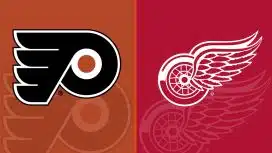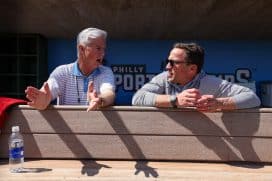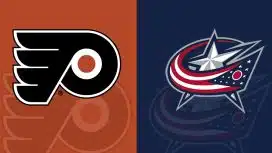Phillies
Top 25 Players to Ever Play a Game for the Phillies: No. 21, Cole Hamels
By Paul Bowman, Sports Talk Philly Staff
So far, the countdown of the greatest players to ever wear a Phillies uniform has focused on players from the past. A few have retired and a few have been out of the Major Leagues for a season, making their futures in the game uncertain. At No. 21 on SportsTalkPhilly.com’s Top 25 Players to Ever Play a Game for the Phillies countdown, we have the first player who is currently in the midst of his career, Cole Hamels.
A first round pick by the Phillies in the 2002 draft, Hamels began his career with the team out of high school. He made his way through the system at a high rate for a pitcher, making scarce starts due to two injuries in 2004 and 2005. By 2006, the Phillies thought he was ready.
He was ready.
For the next 10 seasons, Hamels started 294 games for the Phillies, posting a 3.28 ERA over that time. He also posted a 3.09 ERA in 13 postseason starts for the Phillies. Over that time, he was part of arguably two of the best rotations the Phillies have ever had, R2C2 and the Four Aces, along with Cliff Lee, Roy Oswalt and the late Roy Halladay.
Just before the non-waiver trade deadline in 2015, Hamels was traded along with Jake Diekman to the Texas Rangers where he would be part of a rotation that was highlighted by Yu Darvish. Although he has dealt with a few injuries since then, Hamels has posted a 3.68 ERA over 68 starts. He earned his fourth All-Star game nomination, his first with the Rangers, in 2016.
Hamels has never won a Cy Young award. He is not talked about nearly as much as other pitchers like Clayton Kershaw and Felix Hernandez. When he was as a rookie, he was overshadowed by pitchers like Brett Myers. When he began to peak, he was overshadowed by the acquisitions of Lee and Halladay. Then, when he was the clear ace of the pitching staff, the Phillies stopped providing him with run support. Since being traded to the Rangers, his team has gone 38-18 in games he’s started.
Hamels has an outside chance, if he has tremendous longevity, to build a case for the Hall of Fame. He is a lock for the Phillies Wall of Fame when his time comes. However, there is no argument that he is one of the Top 25 Players to Ever Play a Game for the Phillies.
Career Accomplishments
- 2008 World Series MVP
- 2008 NLCS MVP
- 2008 National League Babe Ruth Award
- Four All-Star Game Appearances (2007, 2011, 2012, 2016)
- Four top 10 Cy Young Award finishes (2007,2011, 2012, 2014); one top-five finish (2011)
- Led the National League in WHIP in 2008 with a Whip of 1.082
- Has pitched 16 complete games, seven of which were shutouts
- 2008 World Series champion
- Member of the 2011 Phillies, who won a franchise-record 102 games during the regular season
*Awards were not factored into the formula
Career Defining Moment
When a player plays 10 or more seasons for one team at the level that Cole Hamels did for the Phillies, there are bound to be many memorable moments. For Hamels, however, the 2008 postseason was the highlight of his career to date.
After pitching eight innings in the NLDS and 14 on his way to being named the NLCS MVP, Hamels had his first three postseason wins under his belt. His performance did not go unnoticed, and the then 25-year-old lefty was pegged to start Game 1 of the World Series.
The Phillies could not have asked Hamels for a better performance. Through seven innings, Hamels struck out five and allowed only two runs on five hits and two walks. When the Tampa Bay Rays took Game 2, a Game 5 was inevitable. After the Phillies took games three and four, the club turned to their young ace to start what could be the final game of the series and win the team’s second World Series title.
That Game 5 has become rather infamous in the baseball world. The weather did not cooperate, and after five and a half innings, the game was postponed. Although the game had started on Monday, October 27, it was not completed until Wednesday, October 29. The game is remembered for how it has impacted the rules of the game, but what is not remembered is that the postponement effectively removed Hamels, who had only thrown 75 pitches so far, from the game. Having given up a run just before the postponement, the game was now tied at 2-2 and Hamels was stuck with a no decision.
Luckily, the rain did not affect the performance too much. Having turned in his fifth straight postseason quality start, and his second on the World Series, Hamels was named the World Series MVP. In his two World Series starts, he went 13 innings, allowing only four runs on 10 hits and three walks with eight strikeouts.
Reasoning for ranking
Hamels has 11 seasons so far in which he has posted a WAR above two. That starts him out with 11 points. In four of those seasons, he posted a WAR above five, netting him another 12 points to bring his total up to 23. His career H/9 is the 129th best all-time, good for an additional point for being in the top 200. Roy Oswalt got a one point boost for his WHIP, but Hamels topped that, posting a career WHIP of 1.164. That is good for 85th all-time and two points for cracking the top 100. Hamels gets his largest statistical category boost from K/9. His career K/9 is 8.48, making him the 30th best in the category. For breaking the top 50, Hamels is awarded four points. That brings his total to 30. That’s seven point higher than Jimmy Rollins, who came in at No. 22 on the list. It is only four behind the player that placed at No. 20, who will be discussed on Monday.
Previous Entries
Explanation of scientific formula
The player rankings formula combines both traditional and advanced statistics/metrics and assigns a point total to each category.












































